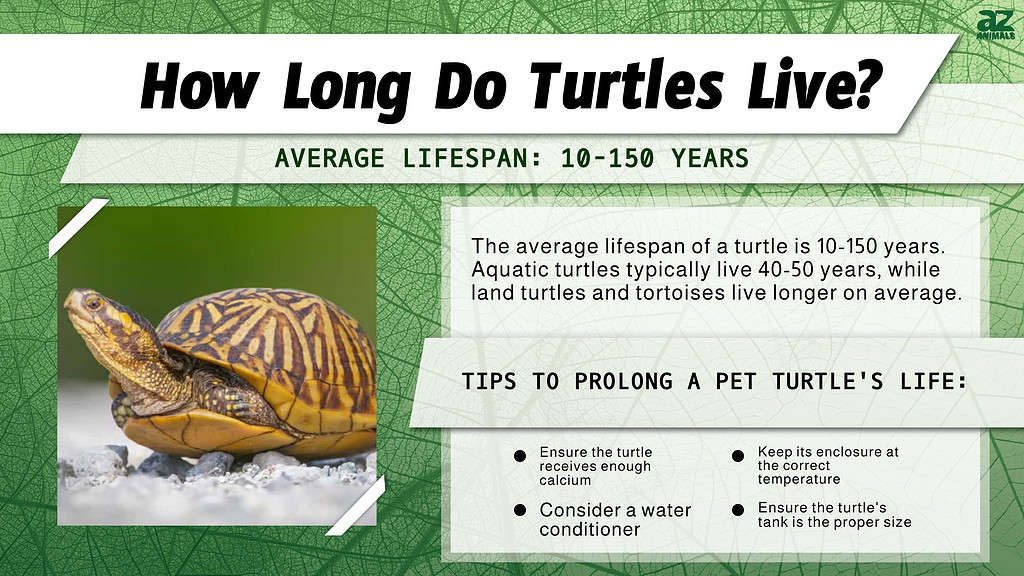Long regarded as one of the longest-living pets you could ever own, turtles surprise many pet owners with how long they can live. Whether you have a red eared slider or a map turtle, these reptiles make long-term companions. How long do turtles live, really?

Whether you have a
red eared slider
or a
map turtle
, these reptiles make long-term companions
©Attila N/Shutterstock.com
If you are curious as to what turtle lives the longest, or even how old the world’s oldest turtle is, you’re in the right place. Let’s discuss the average lifespan of a turtle, as well as what a turtle goes through from birth to death.
How Long Do Turtles Live?

Turtles live anywhere from 10 years to 150 years, depending on the species. The average lifespan for aquatic turtles is around 40-50 years old. The level of care while in captivity greatly affects the lifespan of a domesticated turtle.
Both turtles and tortoises live long and healthy lives. There is no clear and present reason why this is, but it’s good news for pet turtle owners! Tortoises typically live longer than turtles do, though they are often confused. Both turtles and tortoises make excellent pets.
Aquatic turtles tend to live fewer years than land turtles or tortoises. This is usually due to the amount of diseases and bacteria present in water. Larger turtles also tend to live longer than smaller ones, like many other animals around the world.
The Oldest Turtles of All Time
Just how old can turtles live? It depends on the species, but here are a few notable records.
- Oldest Tortoise: The world’s oldest tortoise is still alive today! He’s an Aldabra tortoise from Seychelles named Jonathan. Jonathan was born in 1832, meaning that in 2022 he turns 190 years old!
- Oldest Sea Turtle: The oldest sea turtle is hard to verify as aside from zoos they don’t live in captivity. However, a leatherback sea turtle that washed ashore in the UK in 1988 was estimated to be 100 years old.
- Oldest Snapping Turtle: In 2016 an alligator snapping turtle in the Newport Aquarium passed away at an estimated age of 150, making it the oldest snapping turtle on record! The snapping turtle was named Thunder and lived in captivity for the last 25 years of its life.

If a wild newborn turtle manages to survive, its adulthood is generally uneventful.
©iStock.com/Riza Azhari
The Average Turtle Life Cycle
Curious how a turtle is born and raised? Their life cycle is an interesting one. Most turtles are aquatic in nature, so their life cycle involves them reaching the water at a young age. Let’s learn about turtles now, from freshly hatched eggs to living 100+ years!
Newborns
Newborn turtles go through a surprising journey. Their mothers lay hundreds of eggs in warm sands along shorelines and waterways, and leave the eggs without her protection. Tortoises protect their young while turtles do not.
The eggs incubate in the sand for approximately one to two months. The overall temperature of the sand, while the eggs are incubating, determines the gender of the baby turtles. Turtles use a special hooked tooth to peck their way out of their soft shells.
Using the cover of night, newborn turtles crawl across sand and dirt to reach waterways. They are often victims of predator attacks during this time and many newborn turtles do not live through this process.
Young Turtles
If a newborn turtle survives, their young adult life is fairly uneventful. They will grow and gain some weight, but many species of turtles need over a decade to reach sexual maturity. For the most part, young turtles spent their time swimming and eating an omnivore diet.
Sea turtles reach sexual maturity around the age of 20 years old. Red eared slider turtles reach sexual maturity around the age of five to seven and tend to eat a much more carnivorous diet in their youth. This is because they are still growing and need additional protein in their diet.

Red eared slider turtles reach sexual maturity around the age of five to seven, and tend to eat a much more carnivorous diet in their youth.
©Korkin Vadim/Shutterstock.com
Adults
Depending on the species of turtle, adult turtles usually spend an equal amount of time in the water and on land. This is important to know if you plan on bringing an aquatic turtle home to live as your pet.
The minimum age that a turtle will reach is 20 years old, no matter the specific species. Bringing an adult turtle into your home is a lifetime commitment in many ways, as these reptiles live longer than some humans!
The specific species of turtle will also determine how big the turtle gets. For example, red eared sliders typically live to reach up to a foot in length. Sea turtles however can reach multiple feet in length and can weigh hundreds of pounds!
Tips for a Long Life for Your Pet Turtle

Depending on the species of turtle, adult turtles usually spend an equal amount of time in the water and on land.
©David Byron Keener/Shutterstock.com
If you have recently adopted a pet turtle and want to give it a long and healthy life, you’re in the right place. Here are some tips for taking care of your new reptilian friend:
- Make sure they get enough calcium. Turtles require a large amount of calcium in order to build and maintain their powerful exterior shell. There are many different foods that you can feed them that are high in calcium. You can also purchase a powdered calcium supplement and add that to their existing food.
- Keep their enclosure at a certain temperature. Many aquatic turtles enjoy their enclosures on the warmer side, anywhere from 78 to 88 degrees Fahrenheit. Having thermometers both in the water and on the land is a good idea. This way, you always know what temperature it is in the enclosure and you can adjust the temperature accordingly.
- Consider a water conditioner. Not only do you need to clean your pet turtle’s water frequently, but you may also consider a commercial conditioner to help fight any potential diseases and bacteria. One of the leading causes of death in aquatic turtles is waterborne bacteria and fungi. Purchasing a water conditioner or even a water filter for your turtle’s tank can help prevent some of these diseases.
- Make sure the tank is large enough. Turtles may be small at first and might never grow larger than a few inches. However, your turtle needs an ample amount of room to roam, explore, and live. Many turtle experts recommend a tank that is at least 4 feet long, depending on the species of turtle.
The photo featured at the top of this post is © Mark Leung/Shutterstock.com
Thank you for reading! Have some feedback for us? Contact the AZ Animals editorial team.







